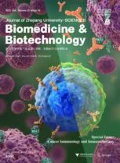Abstract
The objective of this work was to investigate the effect of six individual strains of fungi on the reduction of gossypol levels and nutritional value during solid substrate fermentation of cottonseed meal (CSM). Six groups of disinfected CSM substrate were incubated for 48 h after inoculation with either of the fungi C. capsuligena ZD-1, C. tropicalis ZD-3, S. cerevisae ZD-5, A. terricola ZD-6, A. oryzae ZD-7, or A. niger ZD-8. One not inoculated group (substrate) was used as a control. Levels of initial and final free gossypol (FG), crude protein (CP), amino acids (AA) and in vitro digestibility were assayed. The experiment was done in triplicate.
The experimental results indicated that microbial fermentation could greatly decrease (P<0.05) FG levels in CSM. The detoxification efficiency differed between the species of microorganisms applied. From the perspective of reducing CSM potential toxicity, C. tropicalis ZD-3 was most successful followed by S. cerevisae ZD-5 and A. niger ZD-8. They could reduce FG levels of CSM to 29.8, 63.07 and 81.50 mg/kg based on DM (dry matter), respectively, and their detoxification rates were 94.57%, 88.51% and 85.16%, respectively. If crude protein, amino acids content and their in vitro digestibility were also taken into account, A. niger ZD-8 may be the best choice. The CP content of CSM substrate fermented by C. tropicalis ZD-3 and A. niger ZD-8 were improved by 10.76% and 22.24%, the TAA (total amino acids) contents were increased by 7.06% and 11.46%, and the EAA (essential amino acids) were raised by 7.77% and 12.64%, respectively. Especially, the levels of methionine, lysine and threonine were improved greatly (P<0.05). The in vitro CP digestibility of CSM fermented by C. tropicalis ZD-3 and A. niger ZD-8 was improved by 13.42% and 18.22%, the TAA were increased by 17.75% and 22.88%, and the EAA by 16.61% and 21.01%, respectively. In addition, the in vitro digestibility of methionine, lysine and threonine was also improved greatly (P<0.05).
Similar content being viewed by others
References
AOAC, 1984. Official Methods of Analysis, 13th Ed. Association of Analytical Chemists, Washington, DC.
AOAC, 1999. Official Methods of Analysis, 16th Ed. Association of Analytical Chemists, Washington, DC.
AOCS, 1989. Free and Total Gossypol Methods, Official and Tentative Methods of the AOCS, 4th Ed. American Oil Chemists’ Society, Chicago.
Barraza, M.L., Coppock, C.E., Brooks, K.N., Wilks, D.L., Saunders, R.G., Latimer, G.W., 1991. Iron sulfate and feed elleting to detoxify FG in cottonseed diets for dairy cattle. J. Dairy Sci., 74(10):3457–3467.
Berardi, L.C., Goldblatt, L.A., 1980. Gossypol. In: Liener, I.E. (Ed.), Toxic Constituents of Plant Foodstuffs, 2nd Ed. Academic Press, NY, p.183–237.
Canella, M., Sodini, G., 1977. Extraction of gossypol and oligosaccharides from oil seed meals. J. Food Sci., 42(4):1218–1219.
Cherry, J.P., Gray, S., 1981. Methylene chloride extraction of gossypol from cottonseed products. J. Food Sci., 46(6):1726–1733.
Damaty, S., Hudson, B.J.F., 1975. Preparation of low gossypol cottonseed flour. J. Sci. Food Agric., 26(1):109–115.
Francis, G., Makkar, H.P.S., Becker, K., 2001. Antinutritional factors present in plant-derived alternate fish feed ingredients and their effects in fish. Aquaculture, 199(3–4):197–227. [doi:10.1016/S0044-8486(01)00526-9]
Nagalakshmi, D., Sastry, V.R.B., Agrawal, D.K., 2002. Detoxification of undecorticated cottonseed meal by various physical and chemical methods. Anim. Nutr. Feed Technol., 2(2):117–126.
Nagalakshmi, D., Sastry, V.R.B., Pawde, A., 2003. Rumen fermentation patterns and nutrient digestion in lambs fed cottonseed meal supplemental diets. Anim. Feed Sci. Technol., 103(1–4):1–4. [doi:10.1016/S0377-8401(02)00140-2]
Rahma, E.H., Narasingo Rao, M.S., 1984. Gossypol removal and functional properties of protein produced by extraction of glanded cottonseed with different solvents. J. Food Sci., 49(3):1057–1060.
Robinson, P.H., Getachew, G., de Peters, E.J., Calhoun, M.C., 2001. Influence of variety and storage for up to 22 days on nutrient composition and gossypol level of Pima cottonseed (Gossypium spp.). Anim. Feed Sci. Technol., 91(3–4):149–156. [doi:10.1016/S0377-8401(01)00202-4]
Sakamoto, K., Asano, T., Furuya, S., 1980. Estimation of in vivo digestibility with the laying hen by an in vitro method using the intestinal fluid of pig. Br. J. Nutr., 43(2):389–391. [doi:10.1079/BJN19800103]
SAS, 1999. SAS/STAT User Guide, SAS Online Doc. 8th Ver. SAS Institute, Inc., Cary, NC, USA.
Shi, A.H., Zhang, Y., Qu, P., Yan, J.G., Xiao, H.J., 1998. Screening and breeding of highly-effected degrading cotton-phenol strains and study on detoxification technology and conditions. Acta Microbiologica Snica, 38(4):318–320 (in Chinese).
Tabatabai, F., Golian, A., Salarmoeini, M., 2002. Determination and detoxification methods of cottonseed meal gossypol for broiler chicken rations. Agric. Sci. Technol., 16(1):3–15.
Willard, S.T., Neuendorff, D.A., Lewis, A.W., Randel, R.D., 1995. Effect of FG in the diet of pregnant and postpartum Brahman cows on calf development and cow performance. J. Anim. Sci., 73(2):496–507.
Wu, X.Y., Chen, J.X., 1989. The utilization of microbes to break down FG in cottonseed meal. Scientia Agricultura Sinica, 22(2):82–86 (in Chinese).
Yang, J.L., Zhou, D.Y., Yang, W.H., Zhu, H.Q., 2000. Selection and study of high effective microbiology for digesting free gossypol and proper fermentation processing data for detoxification in cottonseed cakes. Acta Gossypii Sinica, 12(5):225–229 (in Chinese).
Author information
Authors and Affiliations
Corresponding author
Additional information
Project (No. 30471255) supported by the National Natural Science Foundation of China
Rights and permissions
About this article
Cite this article
Zhang, Wj., Xu, Zr., Sun, Jy. et al. Effect of selected fungi on the reduction of gossypol levels and nutritional value during solid substrate fermentation of cottonseed meal. J. Zhejiang Univ. - Sci. B 7, 690–695 (2006). https://doi.org/10.1631/jzus.2006.B0690
Received:
Accepted:
Issue Date:
DOI: https://doi.org/10.1631/jzus.2006.B0690




